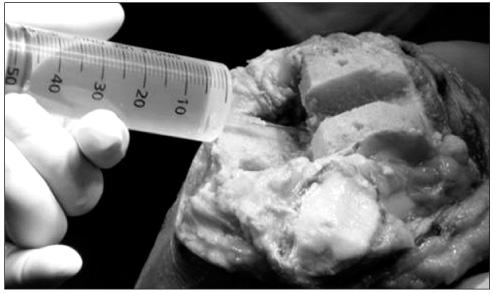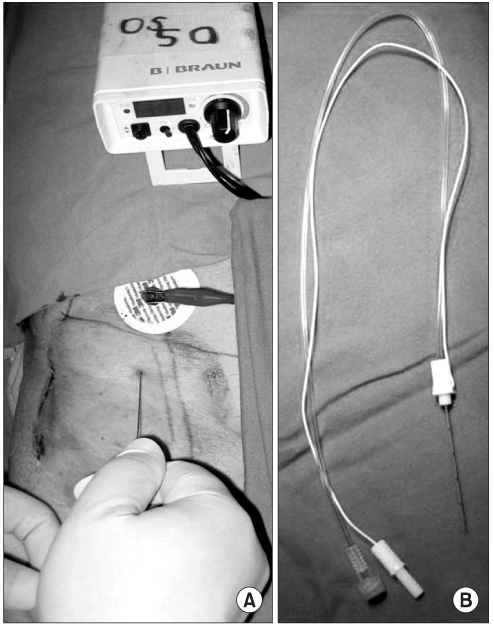J Korean Orthop Assoc.
2011 Jun;46(3):237-243. 10.4055/jkoa.2011.46.3.237.
Effectiveness of Pain Relief for Femoral Nerve Block in Multimodal Pain Control Protocols in Total Knee Arthroplasty
- Affiliations
-
- 1Center for Joint Disease, Chonnam National University Hwasun Hospital, Jeonnam, Korea. seonbell@yahoo.co.kr
- 2Department of Orthopaedic Surgery, Chonnam National University Hospital, Gwangju, Korea.
- KMID: 2185457
- DOI: http://doi.org/10.4055/jkoa.2011.46.3.237
Abstract
- PURPOSE
Authors evaluated the effectiveness of pain relief of the femoral nerve block in multimodal pain control protocols for patients with total knee arthroplasty in early postoperative period.
MATERIALS AND METHODS
Seventy-six patients who underwent TKA under general anesthesia were enrolled in this study. Preemptive analgesic medication, periarticular multimodal drug injection, and IV-PCA were used for pain control in all patients. This single-blind, randomized controlled trial included 43 patients in the nerve block group and 33 patients in the control group. In the former group, the femoral nerve block was done by one author with a nerve stimulator set using 0.5% bupivacaine 20 ml and 1% lidocaine 10 ml. Pain scale was measured at 6, 12, 24, 48, 72 hours and 7 days postoperatively. In addition, amount of IV-PCA consumption, numbers of using acute pain rescuer, range of motion, straight leg raising, first ambulation time, and complications related with drugs were evaluated.
RESULTS
Pain scale and the amount of IV-PCA consumption were significantly lower in nerve block group until 48 hours (p=0.04, 0.03), and the range of motion was better compared to the control group (p< or =0.02). The number of pain rescue medicines was significantly low in nerve block group within the first 3 days postoperatively (1.36 vs 2.58). The ability to raise a straightened leg was recovered more rapidly in the control group than in the nerve block group; this difference was statistically significant (12 vs 27.9 hours, p=0.02). There were no differences in first ambulation time and incidence of complications between the 2 groups.
CONCLUSION
Femoral nerve block in the early period after TKA under multimodal pain control protocols showed significant improvement in pain relief and in range of motion, as well as a significant decrease in the requirement of IV PCA and acute pain rescuers.
MeSH Terms
Figure
Cited by 2 articles
-
Comparison of the Effect of Continuous Femoral Nerve Block and Adductor Canal Block after Primary Total Knee Arthroplasty
Seung Suk Seo, Ok Gul Kim, Jin Hyeok Seo, Do Hoon Kim, Youn Gu Kim, Beyoung Yun Park
Clin Orthop Surg. 2017;9(3):303-309. doi: 10.4055/cios.2017.9.3.303.Comparison of the Effects of an Adductor Canal Block and Periarticular Multimodal Drug Local Injection on Pain after a Medial Opening High Tibial Osteotomy
Ok-Gul Kim, Do-Hun Kim, Seung-Suk Seo, In-Seung Lee
J Korean Orthop Assoc. 2019;54(2):120-126. doi: 10.4055/jkoa.2019.54.2.120.
Reference
-
1. Williams-Russo P, Sharrock NE, Haas SB, et al. Randomized trial of epidural versus general anesthesia: outcomes after primary total knee replacement. Clin Orthop Relat Res. 1996. (331):199–208.2. Enneking FK, Chan V, Greger J, Hadzić A, Lang SA, Horlocker TT. Lower-extremity peripheral nerve blockade: essentials of our current understanding. Reg Anesth Pain Med. 2005. 30:4–35.
Article3. Barrington MJ, Olive D, Low K, Scott DA, Brittain J, Choong P. Continuous femoral nerve blockade or epidural analgesia after total knee replacement: a prospective randomized controlled trial. Anesth Analg. 2005. 101:1824–1829.
Article4. Capdevila X, Barthelet Y, Biboulet P, Ryckwaert Y, Rubenovitch J, d'Athis F. Effects of perioperative analgesic technique on the surgical outcome and duration of rehabilitation after major knee surgery. Anesthesiology. 1999. 91:8–15.
Article5. Singelyn FJ, Deyaert M, Joris D, Pendeville E, Gouverneur JM. Effects of intravenous patient-controlled analgesia with morphine, continuous epidural analgesia, and continuous three-in-one block on postoperative pain and knee rehabilitation after unilateral total knee arthroplasty. Anesth Analg. 1998. 87:88–92.
Article6. Zaric D, Boysen K, Christiansen C, Christiansen J, Stephensen S, Christensen B. A comparison of epidural analgesia with combined continuous femoral-sciatic nerve blocks after total knee replacement. Anesth Analg. 2006. 102:1240–1246.
Article7. White AH. Back school and other conservative approaches to low back pain. 1983. St. Louis: C.V. Mosby;13–14.8. Kardash K, Hickey D, Tessler MJ, Payne S, Zukor D, Velly AM. Obturator versus femoral nerve block for analgesia after total knee arthroplasty. Anesth Analg. 2007. 105:853–858.
Article9. Chelly JE, Greger J, Gebhard R, et al. Continuous femoral blocks improve recovery and outcome of patients undergoing total knee arthroplasty. J Arthroplasty. 2001. 16:436–445.
Article10. Wang H, Boctor B, Verner J. The effect of single-injection femoral nerve block on rehabilitation and length of hospital stay after total knee replacement. Reg Anesth Pain Med. 2002. 27:139–144.
Article11. Ng HP, Cheong KF, Lim A, Lim J, Puhaindran ME. Intraoperative single-shot "3-in-1" femoral nerve block with ropivacaine 0.25%, ropivacaine 0.5% or bupivacaine 0.25% provides comparable 48-hr analgesia after unilateral total knee replacement. Can J Anaesth. 2001. 48:1102–1108.12. Hunt KJ, Bourne MH, Mariani EM. Single-injection femoral and sciatic nerve blocks for pain control after total knee arthroplasty. J Arthroplasty. 2009. 24:533–538.
Article13. Allen HW, Liu SS, Ware PD, Nairn CS, Owens BD. Peripheral nerve blocks improve analgesia after total knee replacement surgery. Anesth Analg. 1998. 87:93–97.
Article14. Hirst GC, Lang SA, Dust WN, Cassidy JD, Yip RW. Femoral nerve block. Single injection versus continuous infusion for total knee arthroplasty. Reg Anesth. 1996. 21:292–297.15. Ben-David B, Schmalenberger K, Chelly JE. Analgesia after total knee arthroplasty: is continuous sciatic blockade needed in addition to continuous femoral blockade? Anesth Analg. 2004. 98:747–749.
Article16. Levesque S, Delbos A. Sciatic nerve block for total-knee replacement: is it really necessary in all patients? Reg Anesth Pain Med. 2005. 30:410–411.
Article17. Bergeron SG, Kardash KJ, Huk OL, Zukor DJ, Antoniou J. Functional outcome of femoral versus obturator nerve block after total knee arthroplasty. Clin Orthop Relat Res. 2009. 467:1458–1462.
Article18. Salinas FV, Liu SS, Mulroy MF. The effect of single-injection femoral nerve block versus continuous femoral nerve block after total knee arthroplasty on hospital length of stay and long-term functional recovery within an established clinical pathway. Anesth Analg. 2006. 102:1234–1239.
Article19. Kim JM, Lee DY, Koh IJ, Kim JI, Ra KH. Effect of regional nerve block in total knee arthroplasty. J Korean Orthop Assoc. 2009. 44:586–592.
Article20. Busch CA, Shore BJ, Bhandari R, et al. Efficacy of periarticular multimodal drug injection in total knee arthroplasty. A randomized trial. J Bone Joint Surg Am. 2006. 88:959–963.21. Mauerhan DR, Campbell M, Miller JS, Mokris JG, Gregory A, Kiebzak GM. Intra-articular morphine and/or bupivacaine in the management of pain after total knee arthroplasty. J Arthroplasty. 1997. 12:546–552.
Article22. Lombardi AV Jr, Berend KR, Mallory TH, Dodds KL, Adams JB. Soft tissue and intra-articular injection of bupivacaine, epinephrine, and morphine has a beneficial effect after total knee arthroplasty. Clin Orthop Relat Res. 2004. (428):125–130.
Article23. Klasen JA, Opitz SA, Melzer C, Thiel A, Hempelmann G. Intraarticular, epidural, and intravenous analgesia after total knee arthroplasty. Acta Anaesthesiol Scand. 1999. 43:1021–1026.
Article
- Full Text Links
- Actions
-
Cited
- CITED
-
- Close
- Share
- Similar articles
-
- Nerve blocks for optimal postoperative analgesia after total knee arthroplasty
- Femoral Nerve Block versus Adductor Canal Block for Analgesia after Total Knee Arthroplasty
- Effect of Regional Nerve Block in Total Knee Arthroplasty
- The relative analgesic value of a femoral nerve block versus adductor canal block following total knee arthroplasty: a randomized, controlled, double-blinded study
- Comparison of the Effect of Continuous Femoral Nerve Block and Adductor Canal Block after Primary Total Knee Arthroplasty



